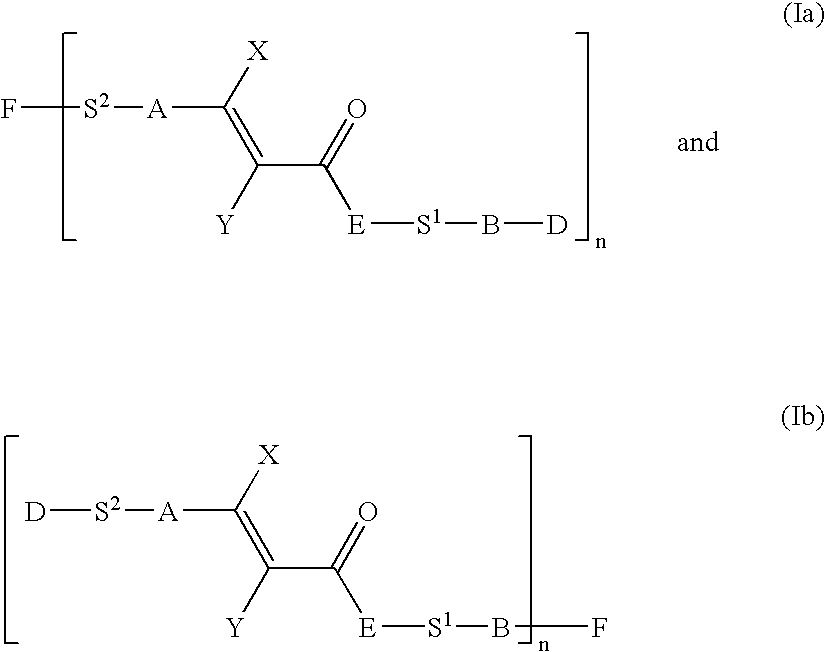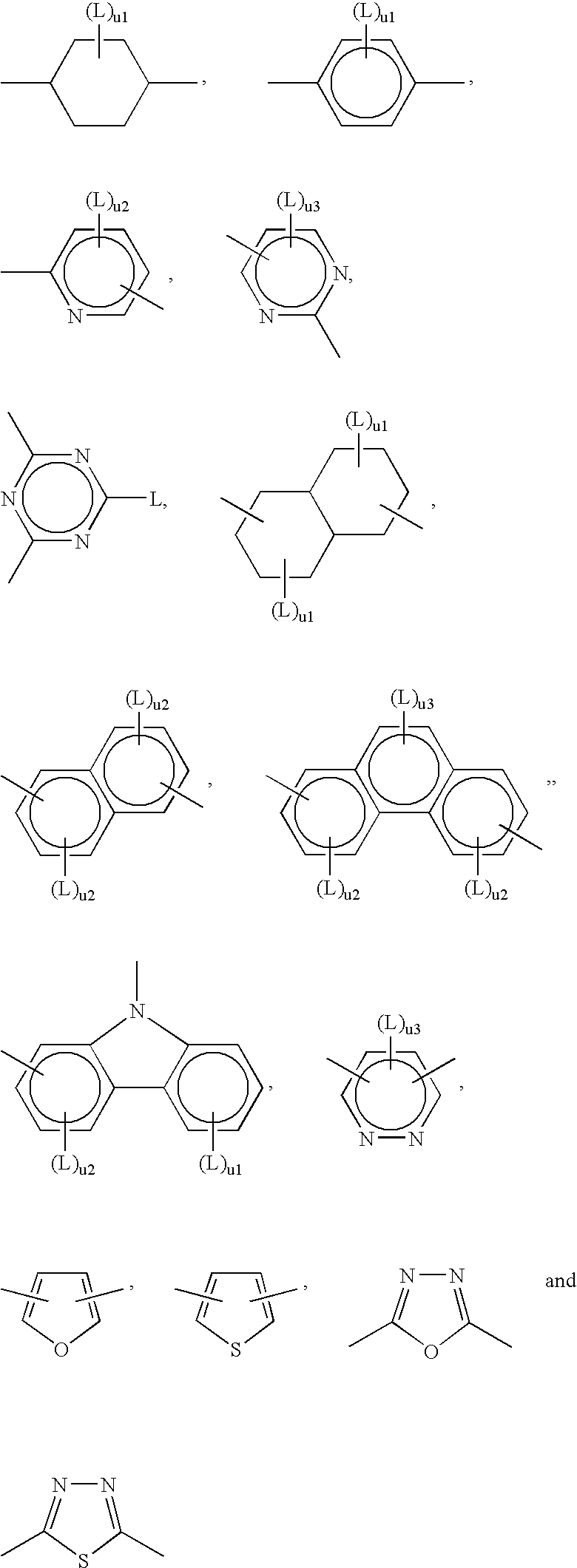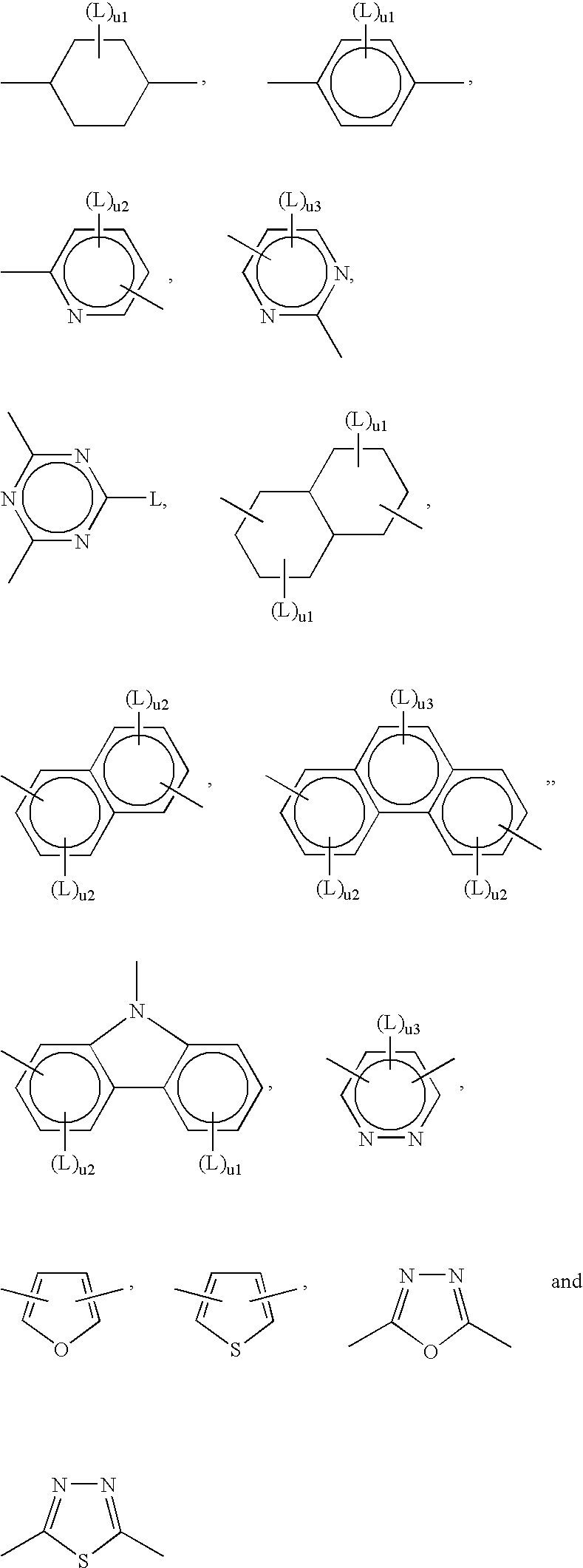Photocrosslinkable Materials
a crosslinking material and photoelectric technology, applied in the field of diamine compounds, can solve the problems that molecular structure types, primarily developed for tn applications, cannot be directly utilized in mva applications
- Summary
- Abstract
- Description
- Claims
- Application Information
AI Technical Summary
Benefits of technology
Problems solved by technology
Method used
Image
Examples
example 1
Synthesis
Preparation of 6-{4-[(1E)-3-(4-pentyloxyphenoxy)-3-oxoprop-1-enyl]phenoxy}hexyl 3,5 diaminobenzoate in accordance with the following procedure
1.1 (2E)-3-{4-[(ethoxycarbonyl)oxy]phenyl}acrylic acid
[0196]
[0197] 67 g (0.41 mol) p-cumaric acid were added to a mixture of 50.4 g (0.90 mol) potassium hydroxide and 600 ml water. 53.1 g (0.50 mol) ethyl chloroformate were added dropwise at 0° C. The reaction temperature rose to 10° C. The reaction mixture was subsequently allowed to react for 2 h at 25° C. and acidified to pH=1 with 200 ml hydrochloric acid 7 N. The product was filtered off, washed with water and dried under vacuum to give 95.3 g of (2E)-3-{4-[(ethoxycarbonyl)oxy]phenyl}acrylic acid as white powder.
1.2 4-pentoxyphenyl (2E)-3-{4-[(ethoxycarbonyl)oxy]phenyl}acrylate
[0198]
[0199] 23.00 g (97 mmol) 4-pentoxyphenol, 17.6 g (97 mmol) (2E)-3-{4-[(ethoxycarbonyl)oxy]phenyl}acrylic acid and 1.18 g (9.7 mmol) 4-dimethylaminopyridine were dissolved in 300 ml of dichloromet...
example 2
Polymerisation Step A
Formation of the Polyamic Acid
[0357] 630 mg (3.210 mmol) of 1,2,3,4-cyclobutanetetracarboxylic acid dianhydride were added to a solution of 2.000 g (3.570 mmol) of 6-{4-[(1E)-3-(4-pentyloxyphenoxy)-3-oxoprop-1-enyl]phenoxy}hexyl 3,5 diaminobenzoate (EXAMPLE 1) in 14.0 ml of tetrahydrofuran (THF). Stirring was then carried out at 0° C. for 2 h. Then another 0.070 mg (0.357 mmol) of 1,2,3,4-cyclobutantetracarboxylic acid dianhydride were added. The mixture was subsequently allowed to react for 21 h at room temperature. The polymer mixture was diluted with 14 ml THF, precipitated into 800 ml diethyl ether and collected by filtration. The polymer was reprecipitated form THF (40 ml) into 1400 ml water to yield, after drying at room temperature under vacuum, 2.35 g of Polyamic Acid No. 1 in the form of a white powder; [η]32 0.71 dL / g.
example 3
Polymerisation Step B
Formation of the Polyimide
[0358] 0.50 g of Polyamic Acid No. 1 obtained in above EXAMPLE 2 were dissolved in 3 ml of 1-methyl-2-pyrrolidon (NMP). Thereto were added 0.28 g (3.57 mmol) of pyridine and 364 mg (3.57 mmol) acetic acid anhydride, and the dehydration and ring closure was carried out at 80° C. for 2 h. The polymer mixture was diluted with 1.5 ml NMP, precipitated into 100 ml diethyl ether and collected by filtration. The polymer was reprecipitated from THF (10 ml) into 200 ml water to yield, after drying at room temperature under vacuum, 0.55 g Polyimide No 1; [η]=0.30 dL / g.
PUM
| Property | Measurement | Unit |
|---|---|---|
| Fraction | aaaaa | aaaaa |
| Fraction | aaaaa | aaaaa |
| Time | aaaaa | aaaaa |
Abstract
Description
Claims
Application Information
 Login to View More
Login to View More - R&D
- Intellectual Property
- Life Sciences
- Materials
- Tech Scout
- Unparalleled Data Quality
- Higher Quality Content
- 60% Fewer Hallucinations
Browse by: Latest US Patents, China's latest patents, Technical Efficacy Thesaurus, Application Domain, Technology Topic, Popular Technical Reports.
© 2025 PatSnap. All rights reserved.Legal|Privacy policy|Modern Slavery Act Transparency Statement|Sitemap|About US| Contact US: help@patsnap.com



